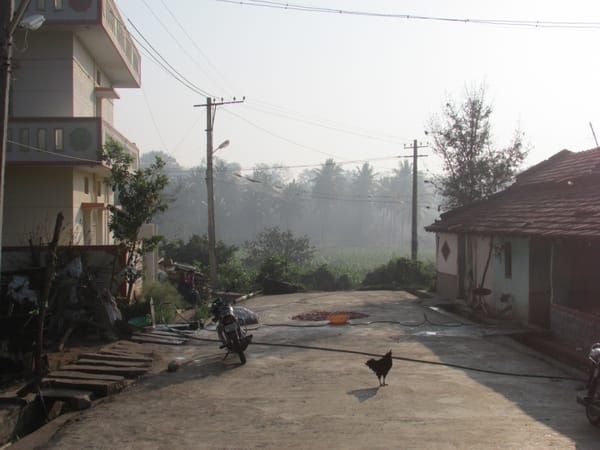
Villagers of Gonipura, Thippur and Sigehalli near Bidadi are largely dependent on farming for their livelihood. Pic: Akshatha M
Krishnappa, a small farmer in his late 60s, vividly remembers the day 18 years ago, when he first received a government notice which said his five-acre agricultural land was notified for a road and township project. The notice came as a shocker to him as well as his fellow-villagers in Thippur, a quiet rural suburb near Bidadi located in Bengaluru South taluk.
Little did Krishnappa and the villagers know about this mega project that would one day put their lives in trouble. He, like everyone else in his village, had previously heard occasional snippets about land acquired for “NICE road” in other parts of the city, but the news of land acquisition came knocking at his door one day in 1998, when he had least expected it.
“The officials said they were going to build a road and a township here, hence they would acquire our land. We had no clue why our fertile farmland was to be taken away for a mega project,” he recalls, sitting in his verandah in a modest house built next to his field.
1998 was the year when the lives of hundreds of farmers in three villages – Gonipura, Thippur, Sigehalli – near Bidadi, were mired in uncertainty. The Karnataka Industrial Area Development Board (KIADB) issued a preliminary notification to acquire 1,916 acres of fertile agricultural land in the outskirts of Bengaluru, for the State government’s ambitious Bangalore-Mysore Infrastructure Corridor (BMIC) project.
The notification came as a shocker to these villagers, more so because KIADB had already notified over 2,000 acres of land in six other villages in Kengeri for the peripheral road and Township-1 project. But one fine day, the alignment of the road was modified to keep the project out of the greenbelt area and it was decided to shift the peripheral road and Township-1 project from Kengeri to the villages near Bidadi.
“We did not know why they (NICE Ltd) eyed our land. This was the land we were born and brought up in and the very thought of losing our livelihood made us feel miserable,” Krishnappa says.
Thus began the struggle of these farmers spread over three villages, against the massive road infrastructure project by Nandi Infrastructure Corridor Enterprise (NICE), proposed to accommodate the projected increase in Bengaluru’s traffic.
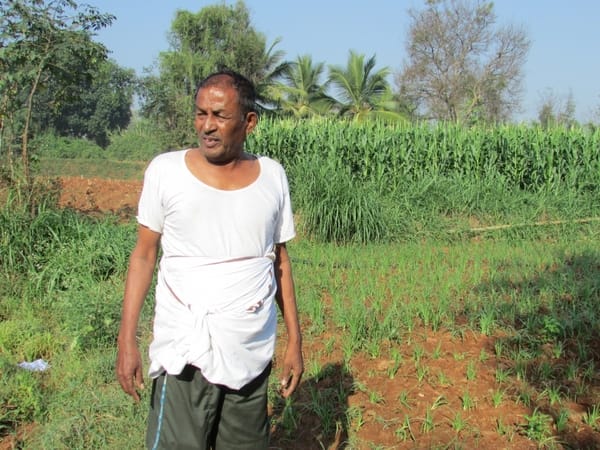
Krishnappa, a farmer in his 60’s, is one among several farmers whose agricultural land was notified for NICE road and township project. Pic: Akshatha M
Nineteen years on, the status of their land continues to be “KIADB-notified” for the NICE road and township project. The land has not been acquired and handed over to the project proponents, and the project remains embroiled in several litigations.
No fresh plantation, no new houses on notified lands
For Krishnappa and several other farmers like him, living in a land notified for an infrastructure project for close to two decades has been a matter of distress.
“We all live in apprehension of losing the land. We cannot invest or develop the agricultural land when there is no guarantee that it will remain with us,” Krishnappa says.
While he dug a borewell to supply water to his farm land a decade ago, he says he would think twice before digging another borewell. “You invest Rs 2 lakh for a borewell and what if you lose the land one day? The investment made on the land after notification will not be considered while calculating compensation,” he tells.
Another farmer, Venkatesh who lives in Lingapura adjacent to Thippur says the project has disturbed his peace of mind. “We cannot take the risk of planting coconut trees or other high yielding crops. If I plant coconut saplings, it will take five years to grow, what if my land is acquired by then? Can I invest my money and energy on crops when I am not even sure if the land will remain with me forever?” he asks.
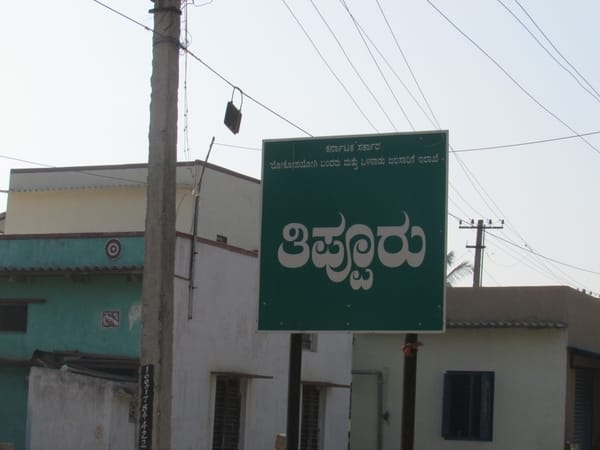
Thippur village near Bidadi, where all farm land has been notified for NICE road and township project. Pic: Akshatha M
His wife Prema says most of the farmers living in the notified villages do not even think of renovating or building a new house. “How can one bear the sight of a newly built house getting demolished right before our eyes?” she questions.
And when the land rates fall
The Land Acquisition Act of 2013 prevents a person from selling the land or doing any transaction once the preliminary notification is issued. But the older law, the Land Acquisition Act of 1894 did not prevent the landowner from selling the land that has been preliminary notified. In normal circumstances, the landowner could sell the property by obtaining permission from the Special Land Acquisition Officer. In the case of NICE project, the old land acquisition law is applicable to the notified land (except for compensation part), and naturally many people tried to sell the land that was notified, as there was uncertainty over the project becoming a reality.
The major problem that the farmers saw was the dip in land rates. Kumar, a resident of Gonipura village and former gram panchayat member says, the maximum price that an acre of land fetches in the notified villages is Rs 40 lakh, while a similar plot is sold for Rs 80 lakh to Rs 1 crore in the neighbouring non-notified villages.
“This is because the Price Fixation Committee (chaired by the Deputy Commissioner) fixed compensation at Rs 41 lakh per acre for the notified land in these villages in 2012. So naturally buyers would not want to purchase our land for anything more than Rs 40 lakh,” he explains.
R Sheenappa who lives in Lingapura shares that the owners of non-notified land in neighbouring villages like Thittalli have sold their land for Rs 1 crore per acre.
“The latest price at which a villager sold his half acre land in Gonipura was Rs 20 lakh,” Kumar states. In addition, he says there are no takers for land parcels within the acquisition limits. “Why would anyone want to buy land that has been notified for a project? Even if a person is willing to buy the notified property, the registration process is a hassle,” he says.
Though selling the notified land in itself is a challenge, the farmers in these villages clarify that they do not want to sell their entire property and relocate from the village. The only reason why they may wish to sell a parcel of their land to any willing purchaser is to repay loans or to raise money for their children’s wedding.
“Marriage is a big expense,” says Narayanaswamy, father of four children. Every family that this reporter spoke to said that the only time they would think of selling a land parcel is when they have to spend on their children’s marriage.
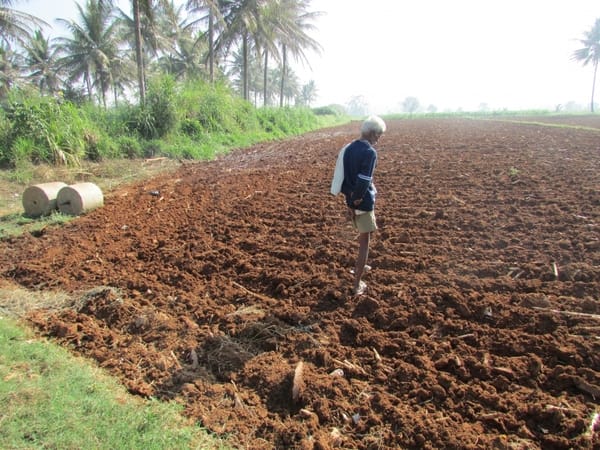
A farmer, Narayanaswami, walks on his agricultural field even as he explains how he nurtured his four children with the earning that he got from his five acre land. Pic: Akshatha M
“We would spend Rs 5-10 lakh for a marriage. That is the time when we might be desperate to sell a part of our land. But with the low price fixed for our property and the land being notified, no one is ready to pay the actual market price. People here are incurring losses. A lot of them are worried about repaying the loans,” Narayanaswamy tells.
A fight to retain the land
Grievance meetings, requisitions, protests, padayatras… these farmers have seen it all. After 19 years of fighting the battle against the government and the project proponent, they have emerged much stronger now. A majority of the villagers do not want to lose their land for the township at any cost, while they are fine with giving up some land for the road project.
When the KIADB issued the first notice in 1998, the farmers were not so reluctant to part with the property, says Krishnappa. “Initially we were offered a compensation of Rs 6 lakh per acre. It was a good deal then. With that money, we had an option to relocate to villages in Ramanagara, Channapatna or Tumkur where we could have bought farmland at a much cheaper price. But the delay in implementing the project has only worsened the situation. Now we cannot even think of relocating to other districts as the land rates are much higher than the compensation offered to us,” the farmer explains.

Framers in Gonipura, Thippur and Sigehalli villages grow ragi, maize, dal, peanuts and veggies in their fertile agriculture land. Pic: Akshatha M
Meanwhile, in the neighbouring Sigehalli village, on a lazy afternoon the long conversation between the villagers about land acquisition reflects why they wouldn’t want to leave their agricultural land.
The villagers gossip about the plight of people in Hampapura, a village in their vicinity, who lost their land a few years ago. A car manufacturing company apparently acquired a few hundred acres of agricultural land in Hampapura.
“They (villagers) gave up the land to the car manufacturing company as they were lured with money. When the lump sum compensation money was exhausted, they approached the company demanding jobs. The company denied and the families were forced to live their lives on the footpath,” Narayana, a villager describes.
“We do not want to face such a situation,” a woman adds.
Not in favour of selling lands
Narayana is proud when he says that not even a single family has sold its property in Sigehalli so far. “In the neighbouring Thittalli, farmers have sold conversion land for crores of rupees which were then made into layouts. But we do not want to follow in their footsteps,” he declares.
Farmer Venkatesh has understood the advantages of owning land over money only too well. “If we sell our land, will the compensation money, even if it is in crores, stay with us till the end? We will probably end up overspending on needless things, our kids may develop bad habits. But this land, which we sow and reap, is a permanent asset, an asset that provides us a decent living,” he says.
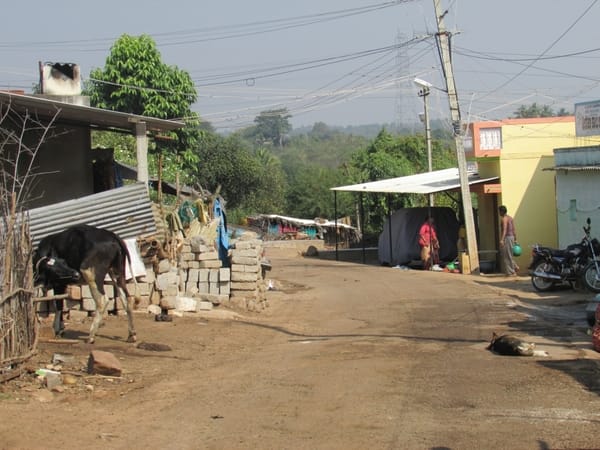
Villagers of Sigehalli take pride in saying none of them have sold an inch of land to private builders. Pic: Akshatha M
After two decades of restless struggle, the farmers hope that the State government will drop the project and their fertile agriculture land will be denotified. They see a ray of hope in the recommendations of the Legislative House Committee that recently probed and submitted a report on alleged irregularities in the BMIC project. The Committee in its report has pointed out several irregularities in the BMIC project and has recommended that the land notified for the road and township project be withdrawn and made free from the project.
“We have heard that the Committee has submitted a report to the government in our favour. We are only hopeful that the government, whichever it is, will decide to drop the township project and free our land from notification,” says Phalanethraiah, a resident of Gonipura, while several other farmers surrounding him nod in agreement.
Related Articles
KIADB starts land acquisition for Metro Phase – II
Citizens revolt at BBMP land acquisition for road widening
Is the land acquisition law absolute?
Save KR Market from landgrabbers
Successive governments let Apollo off on land grab: Task force report
Beware, the BDA fuels land grabbing
Church to builder to courts to demolition, a land grab ends
BDA in its Revised Master Plan, Bangalore 1995 proposed peripheral Ring Road (PRR) all-round the City. PRR is outside the Outer Ring Road (ORR) proposed in the earlier Master Plain-1984. ORR was carrying heavy traffic and bye pass Road for through traffic connecting National Highways and State Highways was required. To implement the PRR the State Government decided to entrust NICE the portion from Tumkur Road to Hosur Road. BDA was supposed to form the portion between Hosur Road to Tumkur covering eastern and northern parts of the City connecting Sarjapur Road, continuation of HAL Airport Road, White Field Road, Old Madras Road, Banaswadi Road, Hennur Road, Bellary Road, Doddaballapur Road and Tumkur Road. Nice Company, a private profit making enterprise was given the opportunity to collect toll from through traffic users. But the very big reward given by the State Government was to give vast areas of land to the entrepreneur for developing his own townships on Bengaluru Mysore Road. When collecting toll was allowed, why land for five townships was given by acquiring lands from farmers to the profit making entrepreneur . Government has not taken action later on land notified for NICE. After increase in land values, the entrepreneur has sold some of the lands at higher land values. The townships have not come up. Later, there was misunderstanding between State Government and NICE. Only the toll highway is functioning.
Let not State Government make such commitments for the benefit of private entrepreneurs to use the lands acquired from poor farmers.
-Dr. A. S. Kodanda Pani,
Urban Planner & Civic Analyst